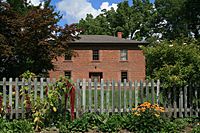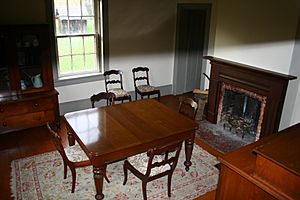Backus-Page House Museum facts for kids

Backus-Page House Museum, August 2008
|
|
| Lua error in Module:Location_map at line 420: attempt to index field 'wikibase' (a nil value). | |
| Established | 1994 |
|---|---|
| Location | Wallacetown, Ontario, Canada |
| Type | Historic house museum |
The Backus-Page House Museum is a special place where you can experience history! It's like a "living museum" in Wallacetown, Ontario, Canada. This museum is inside a beautiful house built in the Georgian style. It has been carefully restored to look just like it did in 1850. The Tyrconnell Heritage Society, a local group, takes care of the museum. They work hard to keep the house and its land looking great and teach people about its past.
Contents
Discovering the Backus-Page House
The Backus-Page House Museum is located inside John E. Pearce Provincial Park. This area was once known as the Talbot Settlement. The museum is in a restored Georgian-style house. It was built in 1850 by a builder named Robert Morris.
This house is very important because it was one of the first brick homes built in Dunwich Township. Robert Morris built many houses, but this one stands out.
Who Lived Here First?
The house was built for Andrew and Mary Jane Backus. The Backus family was one of many who received land from Colonel Thomas Talbot. They settled in this area, which was called Little Tyrconnell. This name came from a place in Ireland.
Andrew built his house on land given to him by his grandmother, Mary Storey. She received her original land grant in 1809. The Backus family did well, as shown by their business records and the quality of their home.
The Backus family called their home "Lakeview." Back then, the land between the house and Lake Erie was clear. This gave them an amazing view of the lake. Today, the area has been reforested, so the view is different.
How the House Was Built
This two-story red brick house was built using about 72,000 bricks. These bricks were made from clay dug right behind the house. They were fired on the farm property itself. The bricks were used for both the inside and outside walls.
The walls were built to be very strong, about four or five bricks thick. The house's frame used strong oak and black ash wood. Much of the other wood, like pine and tulip, came from nearby forests.
The house was heated by three fireplaces on the main floor. Each fireplace had a beautiful black walnut mantel. The fireplaces don't work anymore. However, one still has old cooking hardware, showing it was once used for cooking.
The Page Family's Time at the House
The Backus-Page House and its land were bought by Jonas A. Page in 1925. He later sold it to his son, Morley Page. The Page family had lived in the area since the early 1800s. Morley and Grace Page lived on the farm for over 50 years.
They farmed the land, raising dairy cows, pigs, and chickens. They also grew crops and made maple syrup. Over time, the house changed from its original 1850s look. Morley and Grace's children, Bill and Iris, did not become farmers.
So, Morley and Grace were the last Pages to live on the farm. They sold it to the Ministry of Natural Resources in 1968. They continued to live there until the summer of 1976.
Today, the Ministry of Natural Resources still owns the house. They have an agreement with the Tyrconnell Heritage Society. This society was formed in 1994 to restore the house to its 1850s condition. In 1998, they began the restoration. They renamed the house to honor both the Backus and Page families.
The Page Family's Journey
In 1845, Jonas Page, his wife, and their five-year-old son arrived in Upper Canada. They came from Oxfordshire, England. Jonas wanted to settle in the area and was sent to Colonel Thomas Talbot. Talbot had a large land grant from the British government along Lake Erie. He was in charge of settling the area.
Jonas traveled about 14 kilometers to Talbot's log cabin. Talbot was not in a good mood. When he heard Jonas was from Oxfordshire, Talbot said he wouldn't sell him any land. Jonas didn't give up. He waited a few days and tried again. This time, he was given a piece of land for $2.00 an acre. It was on the shores of Lake Erie, about 2 kilometers west of Port Tyrconnell.
Building a New Life
Jonas cleared the land and built a log house with help from his neighbor, Job Curtis. This was very important. Talbot was known to take back land from settlers who didn't clear and settle it quickly enough. With a home built, Jonas could return to Talbotville. He moved his family by oxen and sled about 20 kilometers through the bush to their new home.
Life for settlers was hard. But people still found time to build a strong community. One of the first projects Jonas helped with was building the First Methodist Church in Tyrconnell in 1855. Jonas loved music. When the church was finished, he would lead the singing, keeping everyone in tune with his tuning fork.
Jonas and his wife had 11 children. Six of them grew up to be adults.
The Tyrconnell Heritage Society
The Tyrconnell Heritage Society is a local group dedicated to restoring and preserving the Backus-Page House. They also work to share the rich history of the Talbot Settlement. The society was started in 1993 when the future of the Backus-Page property was uncertain.
The society became part of the Ontario Historical Society in 1994. Since then, its volunteers have worked hard to achieve their goals.
Restoring History
In 1998, the society signed a 50-year agreement with the Ministry of Natural Resources. This agreement, along with local money and funding from the Ontario Trillium Foundation, allowed them to restore the 1850s Georgian-style house.
Besides restoring the house, the society made the grounds around it larger. They created a picnic area and built a separate building for resources and events behind the house. The Tyrconnell Heritage Society also created three walking trails within John E. Pearce Park, where the Backus-Page House is located.
Education and Community
Today, the society continues to work towards making the Backus-Page House a living history museum. Every year, their special education program allows hundreds of children to experience what life was like for a Canadian pioneer family. As the museum's collection grows, they can offer more exhibits.
The society and the estate grounds host many different events. These range from wedding receptions to company day retreats.
As part of their agreement, the Tyrconnell Heritage Society helps maintain the trails and facilities of John E. Pearce Provincial Park. Society members lead guided hikes. They also support educational and research groups studying the area. They even have a program to record the seasonal changes within the park.
The society is working to expand its education programs to be year-round. They also want to increase museum activities. A big step forward for the estate will be the restoration of the rectory barn. The Tyrconnell Heritage Society is dedicated to making sure the Backus-Page House Museum remains an important historical landmark along Lake Erie's northern shore.


